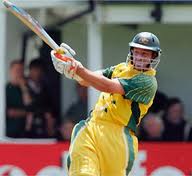World Cup 2011 Quarter-final, 24th March, India Vs Australia, Ahmedabad
By Vikram Afzulpurkar
Who was the real hero, no doubt it was a combined effort that helped India vanquish invincible Australia in the World Cup quarter-final?
Celebrating the 'Heroes'
Well, India performed reasonably in repairing their ‘batting collapse’ gene while beating World Champions Australia. Sure, the whole nation is in raptures because their favourite boy Yuvraj who can send the ball soaring over fences fired off. And the ‘match finisher’ Suresh Raina lived up to his old name.
Introspect
Surely, any side will not be perfect in executing its plan and for this, the India batters may escape flak because they won and also by seemingly a substantial margin of 15 balls and 5 wickets. Let's throw a spanner into the works. The margin was always bound to be the extreme of either 15 balls or close to 0 balls. Raina hit a six when about 20 runs were needed but few would realize that this was ‘the only way to go.’ The Aussies, no doubt a mean fielding bunch, did not have the long off and it was actually easier to do that than hit a 4 or even tickle the ball around for 1 or 2 on the off side.
AAgreed, it takes gumption to play the shot, which Raina displayed. But there is no harm in calling it a regulation strike viewing the fact that India is a world class side. That mentioned, let’s move on to two worrying factors that can be addressed as the side prepares for the next battle.
PROBLEM AREAS FOR INDIA TO ADDRESS:
1. No calling: No doubt Gambhir ‘tried twice before but finally succeeded in the third successive ball to run himself out’ as the commentators dryly added. The real problem would seem to be that Yuvraj was not issuing a ‘no’ call. In the ball where the former was run out, yes, it would seem to be Gambhir’s call because the ball was played behind the stumps. However, Yuvraj, instead of looking up at what his partner was doing, seemed pre-occupied with himself. Gambhir too would be at fault for not calling ‘yes,’ when the call was his, which fact is evidenced by Yuvraj not even looking up after playing the ball. Neither did the stump mic pick up any calling.
 |
| Indians are irked at Gambhir's running but was Yuvraj who later apologised alert enough? |
It would be hard to believe that the Indians are following the ‘striker will call’ method, no matter which part of the field the ball has gone to. (The Australians have followed this since the mid ‘90s, which undoubtedly requires aggressive running). If Gambhir ran so confidently, unfortunately while at fault for not calling, for the ball which was behind the stumps, it would seem the Indians don’t get tangled with this method.
2.
 |
| Mediocrity against a full toss has exposed Kohli |
2. Virat’s dismissal: Agreed that a full toss can make a batsman mistime the ball but Virat Kohli showed a distinctly aggressive path while not being sure where the short mid-on was.His unique technique means his legs cross over to maximize leverage and the bat twists unconventionally, therefore limiting his options for other strokes. But with plenty of time available he could have eschewed the path of glamour.
Missed middle of bat: He failed to digest that he didn’t get the ball onto bat’s sweet spot or for that matter see the closeby mid-on fielder. A dismissal that would popularly rank as ‘soft’ however this batter really needs to take a deep dive. Are his previous century exploits making him feel his has the full repertoire? Is the guarantee given by the team management of his playing all world cup matches making him lax?
Winner factors: After handling our lacunae, let’s identify what real factors tilted the match towards us. Sure, disciplined bowling tamed the Australians. But remember the Aussies are no mean defenders of 260. Factors:
POSSIBLE 'MEN OF THE MATCH':
1. 1. Sachin Tendulkar: Kudos may flow freely to Yuvraj, Raina and even Sehwag but Sachin Tendulkar can be considered the real match winner. Defending 260, the Aussie bowling and fielding raised itself, the former being especially disciplined and backed eagerly by Ponting’s off side cordon prowling in every ball to prompt the uppish stroke. It was the way that Tendulkar handled this that quietly disintegrated the Aussies.
 |
| Was Tendulkar's chiselled 50 worth of the Man of the Match award? |
No Yuvraj, Sehwag, Dhoni or Yusuf heroics would have managed that, where on the contrary each four or six hit by these powerful men at that stage would have made the Australians feel they were closer to drawing blood.
Remember, Dhoni’s famous words about 3 years ago, saying “since the Australians are used to winning matches in a certain way, if you upset that system, they find it difficult to win.” Tendulkar did precisely that for his team. Again, it was not his run-ball strike rate but the method of scoring.
 |
| Did Dhoni's 'mini strokes' to bowl Sachin, Virat take away the Aussies' rhythm? |
2. 2. Dhoni’s surprise overs: Bowling Kohli and Tendulkar for one sudden over each at different stages of the match may each pass over as an unconnected incident to winning the match. Especially since neither over fetched a wicket, nor was a maiden or a very frugal one. However with each of these overs, where about 6 and 9 runs respectively were conceded, the Indian captain had made the Aussie batsmen think instead of settling down to a regular albeit better bowler.
Opposition guessing?: When Kohli and Tendulkar were replaced by other bowlers, the Aussies must have experienced the ‘bluff’ that maybe Dhoni would charge them too, which of course he didn’t. All this cerebral work would have seen 5-6 overs go by, therefore proving an innocuous game changer against a strong Aussie side.







